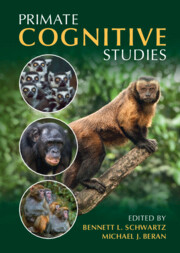Book contents
- Primate Cognitive Studies
- Primate Cognitive Studies
- Copyright page
- Contents
- Figures
- Tables
- Contributors
- Acknowledgments
- 1 The Purpose of Primate Cognitive Studies
- 2 A History of Primates Studying Primates
- 3 Genetic and Environmental Influences on Chimpanzee Brain and Cognition
- 4 The Evolution of Cognition in Primates, Including Humans
- 5 State of the Field
- 6 Current Perspectives on Primate Perception
- 7 The Comparative Study of Categorization
- 8 Numerical Cognition in Nonhuman Primates
- 9 The Natural History of Primate Spatial Cognition
- 10 Progress and Prospects in Primate Tool Use and Cognition
- 11 Sequencing, Artificial Grammar, and Recursion in Primates
- 12 The Evolution of Episodic Cognition
- 13 Metacognition
- 14 Bridging the Conceptual Gap between Inferential Reasoning and Problem Solving in Primates
- 15 The Eyes Have It
- 16 Social Cooperation in Primates
- 17 Primate Communication
- 18 Theory of Mind in Nonhuman Primates
- 19 A Requiem for Ape Language Research
- 20 Primate Empathy
- 21 Replication and Reproducibility in Primate Cognition Research
- 22 Ethical Considerations in Conducting Primate Cognition Research
- 23 Collaboration and Open Science Initiatives in Primate Research
- 24 Studying Primate Cognition
- 25 Do Monkeys Belong in the Ape House?
- Index
- References
20 - Primate Empathy
A Flexible and Multi-Componential Phenomenon
Published online by Cambridge University Press: 28 July 2022
- Primate Cognitive Studies
- Primate Cognitive Studies
- Copyright page
- Contents
- Figures
- Tables
- Contributors
- Acknowledgments
- 1 The Purpose of Primate Cognitive Studies
- 2 A History of Primates Studying Primates
- 3 Genetic and Environmental Influences on Chimpanzee Brain and Cognition
- 4 The Evolution of Cognition in Primates, Including Humans
- 5 State of the Field
- 6 Current Perspectives on Primate Perception
- 7 The Comparative Study of Categorization
- 8 Numerical Cognition in Nonhuman Primates
- 9 The Natural History of Primate Spatial Cognition
- 10 Progress and Prospects in Primate Tool Use and Cognition
- 11 Sequencing, Artificial Grammar, and Recursion in Primates
- 12 The Evolution of Episodic Cognition
- 13 Metacognition
- 14 Bridging the Conceptual Gap between Inferential Reasoning and Problem Solving in Primates
- 15 The Eyes Have It
- 16 Social Cooperation in Primates
- 17 Primate Communication
- 18 Theory of Mind in Nonhuman Primates
- 19 A Requiem for Ape Language Research
- 20 Primate Empathy
- 21 Replication and Reproducibility in Primate Cognition Research
- 22 Ethical Considerations in Conducting Primate Cognition Research
- 23 Collaboration and Open Science Initiatives in Primate Research
- 24 Studying Primate Cognition
- 25 Do Monkeys Belong in the Ape House?
- Index
- References
Summary
Empathy, the capacity to share and understand others’ states, is crucial for facilitating enduring social relationships and managing ingroup and outgroup dynamics. Despite being at the center of much scrutiny and debate in human research, the evolutionary foundations of empathy remain relatively opaque. Moreover, inconsistencies remain regarding definitions and theoretical models, leading to discrepancies in how to systematically represent and address empathy and understand its evolutionary basis. As a complex, multidimensional phenomenon, certain components of empathy are likely to be evolutionarily ancient whereas others may be more derived. As our closest living relatives, nonhuman primates provide an opportunity to explore the evolutionary origins of empathy and its subcomponents. Due to the rich diversity of primate societies, we can comparatively study evidence of affective responding and empathic behavior within the context of different social dynamics and organization. Although studies have been conducted on individual primate species, especially the great apes, direct species comparisons are rare. Here we examine the literature investigating evidence for empathy among primates focusing on its underlying affective and cognitive components. In reviewing the literature, we also highlight species that need more coverage to enhance our overall understanding of how empathy has evolved within the primate order.
- Type
- Chapter
- Information
- Primate Cognitive Studies , pp. 505 - 531Publisher: Cambridge University PressPrint publication year: 2022
References
- 3
- Cited by

